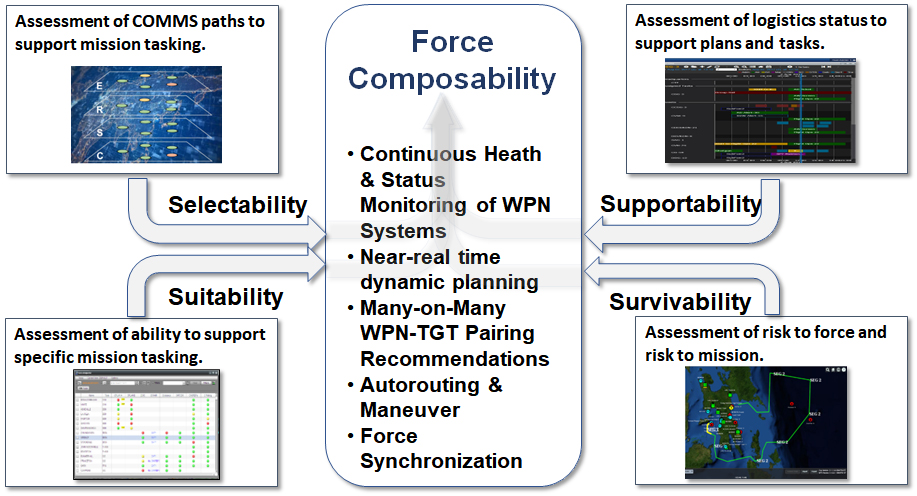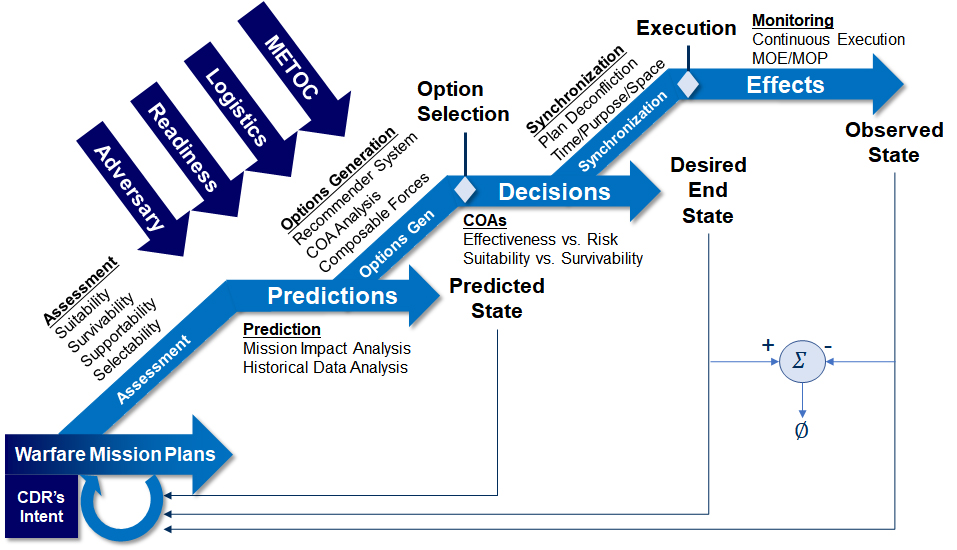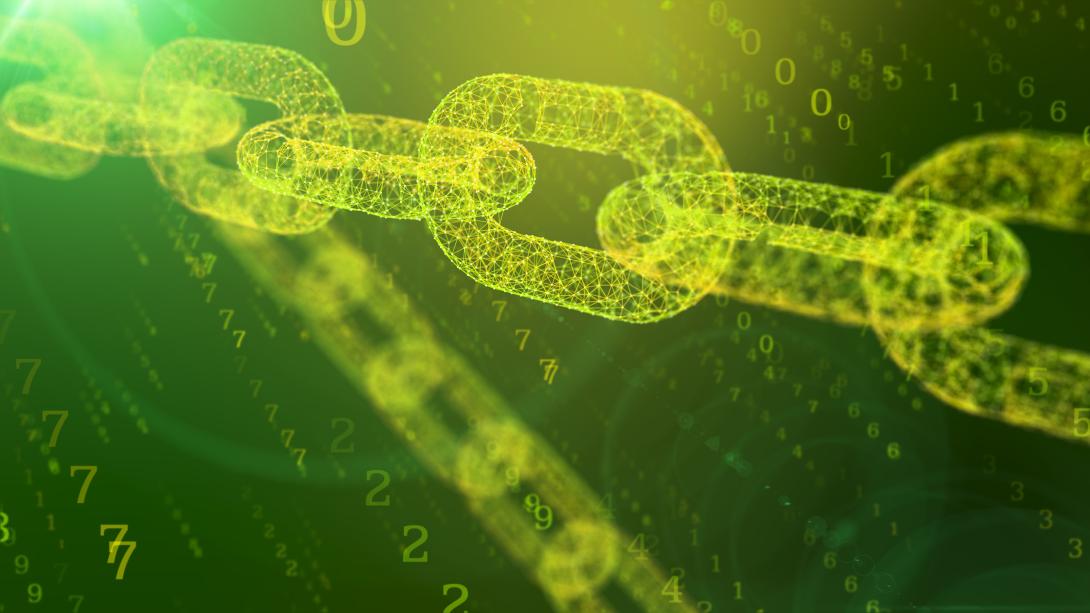The Decision Advantage: Left of the Kill Chain
The advent of more lethal, network-enabled, range-extended and faster weapons reduces the time to engage, critically impacting the time to decide. This time compression can be mitigated by recognizing that decision advantage can be realized using automated approaches to continuously assess the environment to deliver the desired kinetic and nonkinetic effects. In “Rediscover the Art of Command and Control,” Adm. Robert F. Willard, USN (Ret.), highlights that time is the most frequently reapportioned asset. However, the time available within the kill chain to adjust plans is a diminishing resource given the current trajectory of adversary capabilities.
The term “kill chain” references the data paths and systems, including sensors, processors, shooters and operators. Kill chains can be assessed to identify strengths and weaknesses. Christian Brose, author of “The Kill Chain: Defending America in the Future of High-Tech Warfare,” and others have indicated that current kill chain implementations are not as robust or interoperable as desired to support joint maritime dynamic targeting. Gaining the decision advantage required to assess and prosecute adversaries with the speed, agility and maneuver necessary to continuously hold the adversary at risk will require improved capabilities left of the kill chain.
Existing methods and procedures no longer adequately address the temporal and multidomain challenges presented to warfighters. Operating left of the kill chain complements existing find, fix, track, target, engage, assess (F2T2EA) processes and can work within Boyd’s observe, orient, decide, act (OODA) loop. Conducting automated assessments prior to kill-chain execution extends the targeting analytics to the left to continuously recommend many-on-many assets to objectives pairing solutions at machine speeds.
Technological advances can enable forces to act faster by employing automated methods and machine-to-machine interfaces between systems to assess, recommend and generate solutions that can counter and offset adversary capabilities to achieve maritime superiority. One approach to enabling better decisions faster is to holistically understand the battlespace within existing and proposed timelines and timing constraints for all assets in theater. Time is a critical resource for gaining understanding and generating recommendations that can be implemented across the force to fight now.
Continuously generating force recommendations to fight now requires new concepts and capabilities to be in place that can include disseminating data and decisions vertically and horizontally across the force enterprise. In addition to estimating the adversary’s posture, capabilities and intentions, force commanders must have insight into current blue, and allied, asset suitability in the form of system health and status to generate force assignments while minimizing risk-to-force and risk-to-mission. Tasking multiple units along with planning their associated maneuvers to support position and timing constraints and mission dependencies is a formidable objective that requires advanced algorithms to synchronize forces in time, purpose and space. An integrated fighting force enterprise is predicated on understanding and evaluating all systems on all units to maximize the collective effectiveness and efficiencies across all targets.
Continuously holding adversaries at risk requires automated assessment and recommended assignments of Blue Force assets. The left-of-the-kill-chain paradigm is represented by four core tenets: suitability, survivability, supportability and selectability of naval forces. This concept aids Distributed Maritime Operations precepts. With this model, focused analytics can be applied to dynamically determine force composability via evaluating Blue Force strength and mission options that can be executed at specified times and locations.
The suitability of a unit to conduct operations in specific mission warfare areas, such as anti-submarine warfare and anti-surface warfare, involves near-real-time assessment of unit capabilities in concert with the operational status—for example up, down or degraded—of supporting warfare systems. Suitability is decomposed into two components: the feasibility of an asset’s capabilities and limitations to conduct a mission and the preparedness, which reflects the projected health and status or the state of the asset during the planned mission execution time. Suitability can be assessed at the unit level as well as rolled up as an assessment across a strike group.
The survivability of a unit addresses risk-to-force and risk-to-mission. Risk is continuously assessed over the plan of intended movement and includes a unit’s tactical situation posture as well as weather impacts on the mission(s) based on projected sea state and winds.
Supportability considers the logistical aspects to ensure that an asset can support specific mission tasking while maintaining desired thresholds or ensuring that replenishment is practical to reacquire necessary stores within desired time frames. Checklists can be used for initial assessment, but ultimately, the supportability aspect merges logistics with operations planning and is an initial step into the adaptive planning required to ensure force sustainment.

Selectability evaluates the communication links between suitable assets, relay and decision-command nodes during desired time windows. An increased operational tempo will necessitate maximizing machine-to-machine interfaces while minimizing the number of human-in-the-loop decision command nodes. The selectability assessment accounts for bandwidth constraints, quality of service and network topology to support the movement of prioritized data. Instrumented communications channels may be robust enough to support state assessments at the speed of operational needs. In execution, the communication paths are formed via connectivity between line-of-sight and beyond-line-of-sight options across satellite, airborne, shipborne, land-based and weapons nodes. Applications required for assigned missions serve to prioritize movement of requisite data vice moving voluminous data that is not relevant to the planned mission(s) and tasking.
The force composability tenets outlined above provide an operational trade space between effectiveness and risk that automated systems can use to generate many-on-many assignment recommendations across surface, subsurface, land-based and airborne shooters, sensors and communications nodes. The composability concept allows operators to tailor the recommendation system to “focus on what we do have and how to optimally apply it,” as Adm. Scott Swift, USN (Ret.), stated in the perspective needed to fight now. In addition, automation enables operators to focus resources on directing and conducting operations instead of spending valuable time aggregating information, analyzing the status of forces and generating multiple courses of action. These command-and-control functions have been superposed on a prescriptive analytic framework, as shown in the figure above.
The force composability concept supports enhanced situational awareness and recommendations to operators and is realizable in the near term to deliver automated, preplanned responses and increase command and control velocity. The integrated decision analytics framework facilitates on-ramping of advanced capabilities, including artificial intelligence/machine learning, operations research and heuristics, so that joint and allied forces can move toward integrating decision advantage tools using agreed-upon standards and common patterns and practices to expedite the ability to fight now. Kinetic and nonkinetic effects deliver the end game. But continuously building understanding in support of dynamic planning and maneuvering left of the kill chain is critical to the whole game.
Nick Gizzi is the assistant program manager for science and technology at the program executive officer for command, control, communications, computers and intelligence (PEO C4I)/PMW150 Command and Control (C2) Program Office. He is employed by the Naval Information Warfare Center-Pacific (NIWC-PAC).
John McDonnell is the deputy technical director for PEO C4I/PMW150 Navy C2 Program Office. He is employed by the Highbury Defense Group.
Pat Garcia recently retired from the technical director position at PEO C4I/PMW150 and is currently working with Forward Slope Incorporated.
The opinions expressed in this article are not to be construed as official or reflecting the views of AFCEA International.







Comments